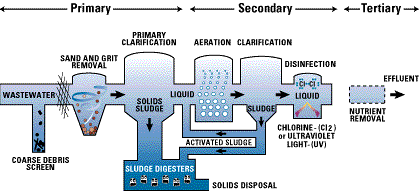Operations/Maintenance
 Operations
Operations
Supervisor: Raymond Scott
Maintenance
Supervisor: Adrian Vasquez
Welcome to the Operations & Maintenance Department
Preliminary treatment at the Yakima Regional Wastewater Treatment Plant consists of mechanically cleaned bar screens and screenings compaction followed by grit removal. After flow measurement through Parshall flumes, wastewater is directed to primary clarifiers. The four 90-foot diameter primary clarifiers are part of the original 1936 construction project. After primary clarification, wastewater gravity flows to the trickling filter pump station where it is distributed over the two trickling filters. The biological treatment in the trickling filters is followed by additional biological treatment in the activated sludge system. Air is supplied to the four aeration basins by 300 horse power blowers through fine bubble ceramic disk diffusers. The four aeration basins are 28 feet deep and hold 1 million gallons each. Two 140-foot diameter secondary clarifiers follow the activated sludge aeration basins. Effluent is sent through tubes exposed to ultra-violet rays (UV Disinfection System added in 2009) before final discharge to the Yakima River.
An odor control system was added to the facility in 1992. Geodesic domes were constructed over the trickling filters as part of this project. Foul air is ducted from certain areas of the plant and treated in two packed tower odor scrubbers. Sludge settled out in the primary clarifiers and wasted from the activated sludge system is pumped to the anaerobic digesters for stabilization. There are three heated and mechanically mixed primary digesters with a combined capacity of 1.6 million gallons and three secondary digesters with flexible membrane gas holder covers. After stabilization in the anaerobic digesters, sludge is dewatered by centrifuge and the resulting biosolids recycled on permitted farmland as a soil conditioner and fertilizer.
In 2000, the plant’s capacity was again expanded to accommodate the closure of the spray field and bring the remaining food processing wastewater into the plant for treatment. The wastewater plant currently receives an average monthly flow near 13 million gallons per day (MGD). Peak flows are during irrigation season, a result of infiltration caused by an aging irrigation system. Infiltration adds approximately 4 MGD to the warm weather flows. The city’s sewer rehabilitation program of pipe replacement and repair over the past few years has reduced flow by over 2 MGD. The current plant capacity is rated near 22 MGD.
New projects include an industrial waste bioreactor which treats “high sugar” food processing waste, phosphorous removal and re-use as fertilizer, methane biogas recovery and re-use to operate WWTP systems, and a biosolids dryer to convert biosolids into “Class A Exceptional” fertilizer.
